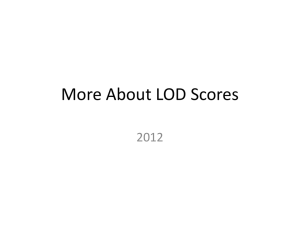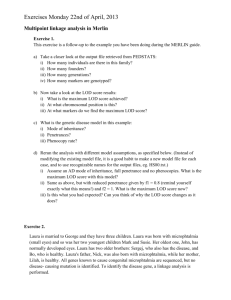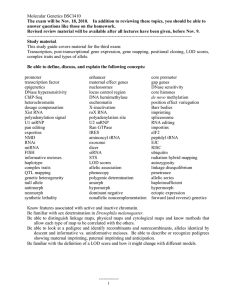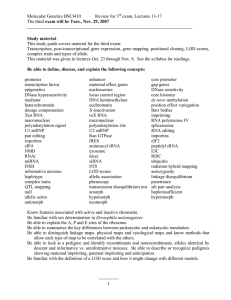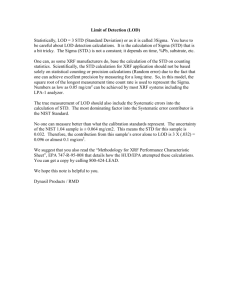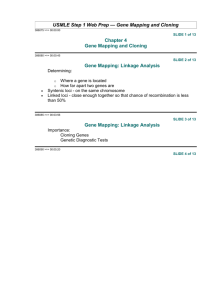Supporting Information Discovery and implications of C and C
advertisement
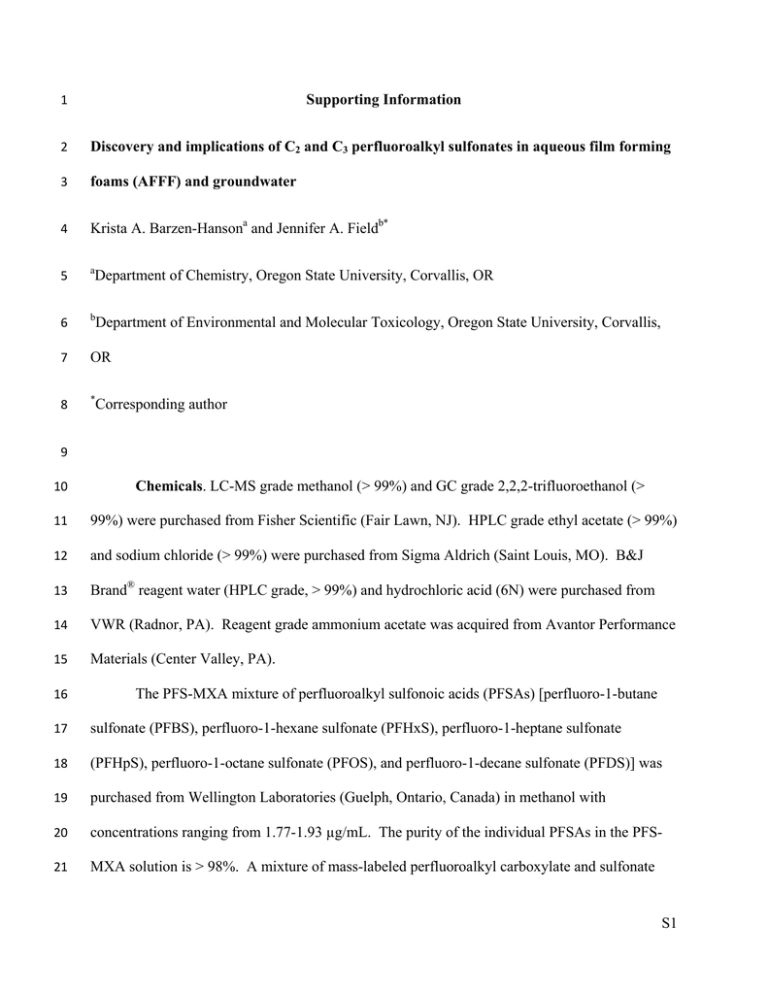
1 Supporting Information 2 Discovery and implications of C2 and C3 perfluoroalkyl sulfonates in aqueous film forming 3 foams (AFFF) and groundwater 4 Krista A. Barzen-Hansona and Jennifer A. Fieldb* 5 a 6 b 7 OR 8 * Department of Chemistry, Oregon State University, Corvallis, OR Department of Environmental and Molecular Toxicology, Oregon State University, Corvallis, Corresponding author 9 10 Chemicals. LC-MS grade methanol (> 99%) and GC grade 2,2,2-trifluoroethanol (> 11 99%) were purchased from Fisher Scientific (Fair Lawn, NJ). HPLC grade ethyl acetate (> 99%) 12 and sodium chloride (> 99%) were purchased from Sigma Aldrich (Saint Louis, MO). B&J 13 Brand® reagent water (HPLC grade, > 99%) and hydrochloric acid (6N) were purchased from 14 VWR (Radnor, PA). Reagent grade ammonium acetate was acquired from Avantor Performance 15 Materials (Center Valley, PA). 16 The PFS-MXA mixture of perfluoroalkyl sulfonoic acids (PFSAs) [perfluoro-1-butane 17 sulfonate (PFBS), perfluoro-1-hexane sulfonate (PFHxS), perfluoro-1-heptane sulfonate 18 (PFHpS), perfluoro-1-octane sulfonate (PFOS), and perfluoro-1-decane sulfonate (PFDS)] was 19 purchased from Wellington Laboratories (Guelph, Ontario, Canada) in methanol with 20 concentrations ranging from 1.77-1.93 µg/mL. The purity of the individual PFSAs in the PFS- 21 MXA solution is > 98%. A mixture of mass-labeled perfluoroalkyl carboxylate and sulfonate S1 22 internal standards (MPFAC-MXA) containing perfluoro-1-hexane[18O2]sulfonate ([18O2]- 23 PFHxS) and perfluoro-1-[1,2,3,4-13C4]octanesulfonate ([13C4]-PFOS) was purchased from 24 Wellington Laboratories in methanol at a concentration of 2 mg/L and are between 94% and 25 99% isotopically pure. 26 Sample Extraction Method. Diluted sample (AFFF or groundwater) was added to a 15 27 mL polypropylene centrifuge tube (VWR) containing 0.97-1.0 g of sodium chloride. All 28 samples for QTOF-MS and LC-MS/MS analyses were acidified with 10 µL of 6N HCl, but only 29 samples for LC-MS/MS analysis were spiked with 1.05 ng of each isotopically-labeled internal 30 standard. Samples for all analyses were extracted three times using 10% (v/v) 2,2,2- 31 trifluoroethanol in ethyl acetate. 32 Modified LC Method. Chromatographic separations were achieved using an Agilent 33 (Santa Clara, CA) 4.6 x 12.5 mm x 5 µm Zorbax silica guard column connected in series to a 4.6 34 x 12.5 mm x 5 µm Zorbax propylamine (NH2) guard column. The silica-NH2 guard columns 35 were connected in series to an Agilent 4.6 x 100 mm x 3.5 µm Zorbax Eclipse Plus C18 36 analytical column. The aqueous mobile phase composition (A) was changed to 3% methanol in 37 HPLC-grade water. The pre-column between the LC pumps and the 6-port valve was removed 38 from the system, and no background PFAS contamination from the LC was observed in solvent 39 blanks. 40 A shallow convex gradient was used to separate the analytes (Figure S1). The mobile 41 phase composition was 3% MeOH in HPLC-grade water (A) and 10 mM ammonium acetate in 42 HPLC-grade MeOH (B). Samples were loaded onto the guard columns for the first 3 minutes in 43 0% B. At 2.6 minutes, the needle, needle loop, and injector valve were bypassed to reduce 44 gradient dwell time. The gradient was ramped to 25% B at 3.5 min and to 50% B at 4.5 min. At S2 45 6 min, the gradient was at 65% B and increased to 90% B at 10 min. The B mobile phase 46 increased linearly from 10 min to 15 min (100% B) and was then held at 100% B for 4 min. The 47 columns were allowed to reequilibrate at initial conditions for 8 min prior to the next injection. 48 The flow rate was constant at 0.5 mL/min. 49 QTOF-MS Parameters. In scanning mode, quadrupole time-of-flight mass spectrometry 50 (QTOF-MS; ABSciex, Framingham, MA) data was collected in 2200 cycles with a period cycle 51 time of 1380 ms, a pulser frequency of 18.079 kHz, and an accumulation time of 250.0 ms. The 52 curtain, nebulizer (gas 1), and drying (gas 2) gases were 25 psi, 50 psi, and 40 psi, respectively. 53 The ionspray voltage was set at 4500 V with a temperature of 500°C, a collision energy of -10 V, 54 and a declustering potential of -80 V. The starting and ending masses were 70 and 1000, 55 respectively, for the survey scan. For the dependent (product ion) scan, the accumulation time 56 was 180 ms, and the collision energy was -40 V. The starting and ending masses were 40 and 57 1000, respectively. Data were collected simultaneously from survey and product ion scanning 58 modes. The instrument was calibrated with the APCI Negative Calibration Solution (ABSciex) 59 before each sample was injected. 60 Error about the Mass Defect (CF2 scale). The error about the mass defect (CF2 scale) 61 was determined using the uncertainty about the accurate mass (up to 5 ppm error).1 From Eq 1 62 (main text), multiplying the error in the accurate mass by a constant did not change the 63 magnitude of the error. Therefore, the mass (CF2 scale) also had maximum error of 5 ppm. 64 Similarly, in Eq 2 (main text), subtracting a constant from the mass (CF2 scale) resulted in no 65 change in the magnitude of the error. Thus, the mass defect (CF2 scale) had a maximum error of 66 5 ppm. S3 67 Quantification by LC-MS/MS. To quantify PFEtS and PFPrS in all AFFF and 68 groundwater samples, chromatographic separations were performed on an Agilent 1100 series 69 HPLC (Santa Clara, CA) that was modified to inject 900 µL. The retention times of each PFSA 70 are listed in Table S2. Details of the modified Backe et al2 method are outlined above. 71 Analytes were detected using a TQ Detector (Waters Corporation, Milford, MA) triple 72 quadrupole mass spectrometer that was controlled with MassLynx 4.1 (Waters Corporation) and 73 interfaced with an electrospray ionization source. The MS/MS was operated in negative mode 74 and multiple reaction monitoring (MRM). The precursor and product ions for both PFEtS and 75 PFPrS observed by QTOF-MS were added to the LC-MS/MS method. The precursor ion for 76 PFEtS was m/z 199 with daughter ions of m/z 80 and 99, while the precursor ion for PFPrS was 77 m/z 249 with daughter ions of m/z 80 and 99. Capillary and cone voltages were not optimized 78 for PFEtS and PFPrS and were instead based on the optimization of PFBS2 since no commercial 79 analytical standards were available. Parameters for the remaining PFSAs were used as previously 80 described.2 81 Quantification of the PFEtS and PFPrS was performed using the analytical standard for 82 PFBS, the internal standard [18O2]-PFHxS, and 1/x weighted calibration curve. Calibration 83 standards were made in a blank extract, which consisted of reagent water taken through the 84 extraction process. Solvent blanks consisted of 1 mL of blank extract, 500 µL of methanol, and 85 1.05 ng of each internal standard. Assuming equal molar response to PFBS, whole method limit 86 of detection (LOD) for PFEtS and PFPrS were estimated to be 0.80 and 2.7 ng/L.2 Whole 87 method limit of quantification (LOQ) for PFEtS and PFPrS were estimated to be 1.0 and 3.3 88 ng/L, assuming equal molar response to PFBS.2 All other PFSAs were quantified as described 89 elsewhere.2 S4 90 Sets of three quality control samples consisting of one solvent blank and two calibration 91 standards were run every 8-10 AFFF and groundwater samples. Acceptable ranges for the 92 quality control standards were ± 30% of the predicted values and below method LOD for the 93 solvent blank. All solvent blanks were found to be below method LOD for all PFSAs. 94 95 S5 96 Table S1. Concentrations of PFSAs in groundwater samples from Sites A-K. PFEtS PFPrS PFBSa PFPeSa PFHxSa PFHpSa PFOSa PFNSa PFDSa (ng/L) (ng/L) (ng/L) (ng/L) (ng/L) (ng/L) (ng/L) (ng/L) (ng/L) A 34 1300 4100 8000 260,000 5900 69,000 99 <LODb B 530 12,000 24,000 14,000c 170,000c 4100c 65,000c <LOD 26c C <LOD 19 85 49 740 37 1900 12 <LOD D <LOD 97 220 170 1200 18 130 <LOD <LOD E 31 2100 3100 1800 33,000 4700 550,000 3000 21 F 11 240 600 410 4800 180 7300 26 <LOD G 4000 63,000 210,000d 220,000d 880,000d 23,000 380,000d 310 9.1 c c c c H 1400 17,000 43,000 38,000 240,000 11,000 78,000 <LOD <LODc I <LOD 62 130 160 5200 130 2500 <LOD <LOD J 220 2600 5800 4000 42,000 2200 92,000 580 30 K 7500 54,000 58,000d 70,000d 360,000d 23,000 210,000d <LOD <LODd a Whole method LOD and LOQ described in Backe et al.2 bConcentration fell below whole method LOD. cConcentrations taken from Schultz et al.3 dConcentrations taken from Backe et al.2 Site 97 98 99 100 101 Table S2. Retention times of PFSAs. Retention time (min) PFEtS PFPrS PFBS PFPeS PFHxS PFHpS PFOS PFNS PFDS 8.38 9.24 9.99 10.67 11.32 11.94 12.31 12.72 13.15 102 103 104 105 S6 100 % MeOH (B) 80 60 40 20 0 0 5 10 15 20 25 30 time (min) 106 107 108 Figure S1. The HPLC gradient conditions used to separate and elute analytes. Flow rate is 0.5 mL/min. 109 110 References 111 112 113 114 115 116 117 118 119 120 S1. Vanderford, B. J.; Mawhinney, D. B.; Rosario-Ortiz, F. L.; Snyder, S. A., Real-time detection and identification of aqueous chlorine transformation products using QTOF MS. Anal. Chem. 2008, 80, (11), 4193-4199. S2. Backe, W. J.; Day, T. C.; Field, J. A., Zwitterionic, Cationic, and Anionic Fluorinated Chemicals in Aqueous Film Forming Foam Formulations and Groundwater from U.S. Military Bases by Nonaqueous Large-Volume Injection HPLC-MS/MS. Environ. Sci. Technol. 2013, 47, (10), 5226-5234. S3. Schultz, M. M.; Barofsky, D. F.; Field, J. A., Quantitative Determination of Fluorotelomer Sulfonates in Groundwater by LC MS/MS. Environ. Sci. Technol. 2004, 38, (6), 1828-1835. 121 122 S7
